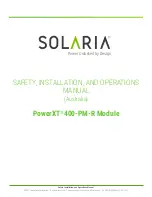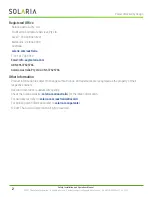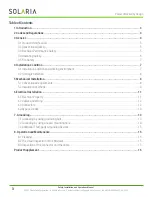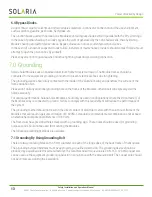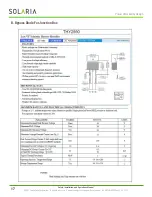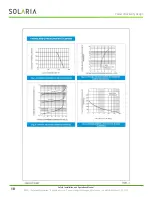
8
Safety, Installation, and Operations Manual
©2021 The Solaria Corporation All rights reserved. Contents subject to change without notice. AUS-MAN-0002 Rev 01, 03-2021
Power Unlocked by Design
4.2 Tilt Angle Selection
The tilt angle of the Modules is measured between the surface of the Modules and a horizontal ground surface. The
Modules generates maximum power output when it faces the sun directly.
In the northern hemisphere, Modules should typically face south, and in the southern hemisphere, Modules should
typically face north.
For detailed information on the best installation angle, please refer to standard solar photovoltaic installation guides
or consult a reputable solar installer or systems integrator.
Dust building up on the surface of the Modules can impair Module performance. Solaria recommends installing the
Modules with a tilt angle of at least10 degrees, making it easier for dust to be washed off by rain.
5.0 Mechanical Installation
5.1 Conventional requirements
Ensure the installation method and supporting system for the Modules is strong enough to withstand all the load
conditions. The Installer must provide this guarantee. The installation supporting system must be tested by a third-
party organization with the ability to analyze Static Mechanical loads, according to the local national or international
standards.
The Modules mounting structure must be made of durable, corrosion-resistant and UV-resistant material.
Modules must be securely attached to the mounting structure.
In regions with heavy snowfall, select the height of the mounting system so that the lowest edge of the Modules is
not covered by snow for any length of time. In addition, ensure that the lowest portion of the Modules is placed high
enough so that it is not shaded by plants or trees or damaged by flying sand.
When the Modules are supported parallel to the surface of a building wall or roof, a minimum clearance of 10 cm
between the Module frame and the surface of the wall or the roof is required to allow air to circulate behind the
Modules and to prevent wiring damage.
Do not attempt to drill holes in the glass surface and the modules frames of the Modules as this will void the
warranty.
Before installing Modules on a roof, ensure that the roof construction is suitable. In addition, any roof penetration
required to mount the Modules must be properly sealed to prevent leaks.
Due to linear thermal expansion of the Modules frames, ensure that the minimum distance between neighbouring
frames is 10mm.
The module frames will warp at low temperature.
Avoid the frame receiving the lateral tension and pressure, causing the frame off or crushing the glass.
Always keep the module backsheet free from foreign objects or structural elements, which could come into contact
with the module, especially when the module is under mechanical load.
The mounting method must not result in the direct contact of dissimilar metals with the aluminum frame of the
Module as it will result in galvanic corrosion. IEC 60950-1 standard recommends metal combinations not exceed an
electrochemical potential difference of 0.6 Volts.

